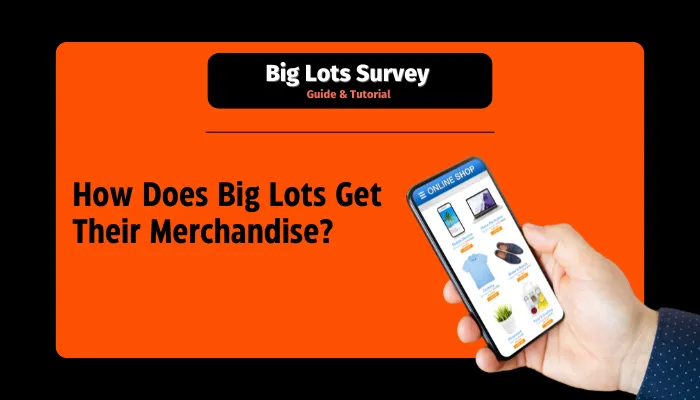Whenever you are trying to shop while looking for the best deals, Big Lots Survey is the store you prefer. Be it furniture, home and kitchen items or even groceries and other seasonal items, this off-price retailer has stood out in the retail market. But have you ever asked yourself,
How Does Big Lots Get Their Merchandise? Let’s look on how Big Lots comes up with its acquisition strategy of the merchandise.

Understanding Big Lots’ Business Model
Big Lots sells closeouts, overstock, and customer returns, it operates as an off-price retailer. As a result, they are able to sell to the public at a reduced rate.
The Genesis of Big Lots
Big Lots was established in the year 1967, where it was known as closeout retailer and the focus was on buying surplus inventory and goods from other companies that were on liquidation.
it is safe since anticipate saying that over the decades, it is developed into a household with hundreds of shops nationwide and still stands out with its broad inventory and prices that are competitive.
The Off-Price Retail Model Big Lots employs the off price retailing model and in simple terms, it’s a situation where Big Lots operates in a buy-sell configuration without following a supply chain.
They operate without relying on fixed prices but instead are able to be aggressive with their pricing.
How does Big Lots get their merchandise under this model?
The explanation is quite simple, Big Lots is able to source their merchandise at substantial discounts from a myriad of suppliers and provide the same to their customers at lower rates.
This model, Big Lots is able to remain cost competitive in the market place and big lots can attract shoppers with new deals every time they walk through the store.
Main Sources Of Merchandise
For Big Lots In order to operate peacefully with their diversified portfolio, it is important to know How Does Big Lots Get Their Merchandise and more importantly from where. Big Lots gets their goods via three channels:
Overstock and Closeouts
Definition: Overstock is the merchandise surplus that a manufacturer could afford as a result of slashing its price. Closeouts are products being sold solely because it discontinued product lines or seasonal changes. –
Examples: Consider that a consumer holiday store realises that the sales forecast for their Christmas tree decorations has a 100% variance level. This not sold stock may end up being sold in Big Lots for a fraction of the cost price.
- Why Big Lots Gets Inventory: Offloading excess inventory quickly supports retailers and manufacturers such as Big Lot’s to free up their warehouse spaces and get back some of these investments.
Liquidations
- Reasons Behind Liquidations: Liquidations happen when there are company bankruptcies, closures of stores, or seasonal changes in inventories.
- Any Merchandise Acquired in Bulk: Big Lots benefits repurchasing vast amounts of merchandise. When a department store goes bankrupt, unsold inventory goes to Big Lots. This allows Big Lots to acquire new products in bulk at discounted rates.
Customer Returns
- Issues of these Returns: These products sold as customer returns include unopened items, other items whose packing is damaged or slightly used goods.
- Business Policy & Guidelines: The next relevant question is How Does Big Lots Get Their Merchandise? The retailer in most cases has stringent policies on issues such as quality assurance to make sure that the wholesale returned goods fetched acceptable standards.
Big Lots’ Merchandise Acquisition Process
The process of acquiring inventory from suppliers to displaying them on store’s shelf portrays in detail about How Does Big Lots Get Their Merchandise with efficiency.
Finding New Suppliers
- Big Lots has a chain of manufacturers including wholesalers and other retailers as suppliers that they never lack in stock.
- The company enjoys credibility with its suppliers and can therefore place bulk orders. Long-Term relationships with suppliers are key.
Negotiating Deals
- Price Bargaining: Big Lots’ buying teams have the belligerent coordination in buying bulk lots of items which results in big savings.
- Significance of Bulk Ordering: Big Lots’ ordering and purchasing of items in huge amounts always gets them items at a lesser cost which is later offered to shoppers.
Logistics and Inventory Management
- Shipping: When the contracts are signed, the bargaining is over. They can wait for the service.
- Storage Facilities: The warehouses of Big Lots function as important centers where merchandise is received and held prior to being shipped to the stores.
- Flow of Stock: The company ensures that inventory does not dry up as far as its clients are concerned, and this is the explanation for how the goods of Big Lots reach its customers; fast and efficient.
Sales and Marketing Strategy and Pricing
Quality Control Measures
Enough attention is given to customer service by Big Lots. A range of characteristics is considered when each product is sold. The purpose of this is to keep the most heavily marked down products reliable at the very least.
Price Setting Policies
- Research Analysis Pricing: Big Lots conducts extensive research on current trends to better capture price points in the market.
- Dynamic Pricing: In order to maximize value for the customers, the prices are changed depending on inventory, demand, or seasonality.
This approach blends dynamically with How Does Big Lots Get Their Merchandise at low rates.
Benefits of Big Lots’ Merchandise Strategy for Consumers
These strategies of sourcing that Big Lots uses make it easier for the shoppers to get what they want at a lower price. This market overwhelmingly loves discounts.
The Pricing is Reasonably Cheap
- Examples: Between 30-70% off from traditional retailers.”
Vast Amount of Choices
- Categories: Oils, furniture, home, cleaning supplies, snacks etc. all are available in the Big Lots.
Fast Selling of Stock
- Fresh Stock: All things are regularly stocked meaning discovering new things every day can stay fun.
So it is not hard to understand How Does Big Lots Get Their Merchandise
Problems, and the Future of Big Lots’ Sourcing
Big Lots is struggling from economic shifts or market adaptation, as well as inconsistent suppliers, however, the future appears rosy with new ways of delivering and adapting to customer needs.
Challenges Faced
- Market Fluctuations: Economical crises and disturbances in supply chains may affect the energy supply.
- Supplier Consistency: Issues in maintaining the quality of new products continuously can arise.
Future Trends
- Emerging Sourcing Strategies: Big Lots might investigate further direct engagement with manufacturers or getting technology that would eliminate intermediaries.
- Satisfying the Demand: In case shoppers’ perception of Big Lots stores and the type of products available in them becomes more ethical and demand for more conservation products arises Big Lots might step up and modify its acquisition cycles.
This may also catch up further and improve the future ways on How Does Big Lots Get Their Merchandise.
Conclusion
Big Lots’ approach towards merchandising is arguably the basis of the corporation’s success. Since they encounter such overstock, liquidation, and returns they supply a fluctuating assortment of their offerings at the cheapest price ever encountered in all stores.
So, How Does Big Lots Get Their Merchandise? The explanation is inclusively based on their potentials for utilizing surplus, opportunity, and surplus into savings and value for their clients. Next time you visit their store, you should also divert your attention to the incredible journey each and every product underwent to find its final station on the stores’ shelves.
